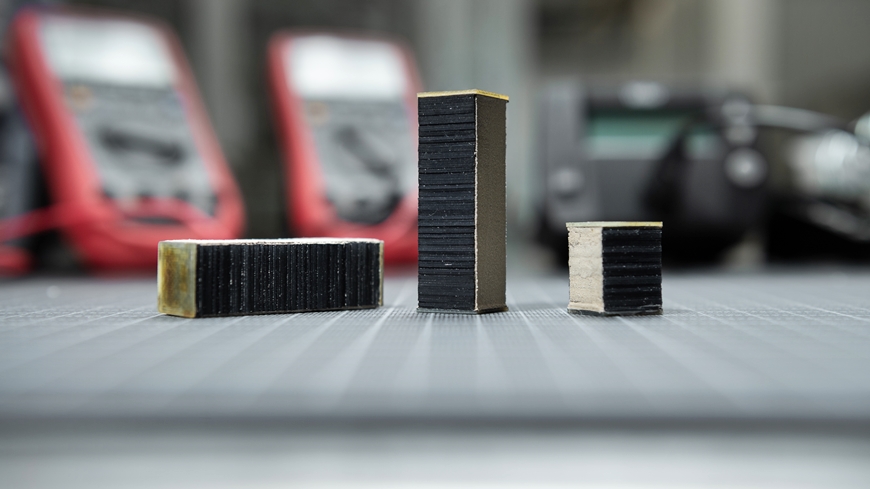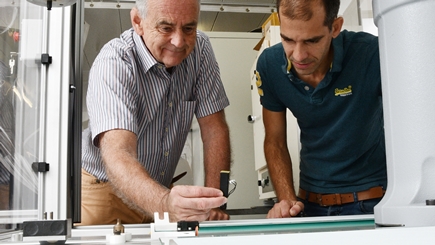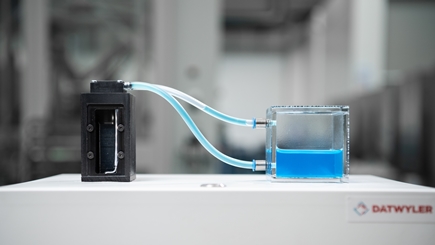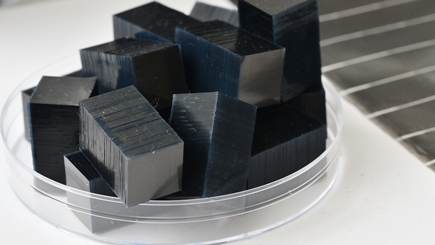Successful spin-off acquisition
CTsystems: A marathon to the market
Developing a product from an innovative technology takes years, sometimes decades. Gabor Kovacs has lived through this process with his spin-off CTsystems AG and electroactive polymers at Empa. From the idea, through creative tinkering, setbacks, progress and the right comrade-in-arms, to the acquisition by a large company: experiences and a conclusion.

The beacons of hope are inconspicuous, tiny, dark gray: wafer-thin square silicone platelets measuring 15 by 15 millimeters on a table in Room 024 of a large hall at Empa in Dübendorf. In a box next to it lies the finished product of hundreds of them stacked into "turrets," with filigree electrode layers in between. When an electrical voltage is applied to such components, the silicone disks are pressed together; the actuator shrinks a little – and can also, vice versa, register electronically when it is pressed together.
Such stack actuators are simpler and cheaper than conventional technology and could be used in a variety of ways: to drive pumps, as switches in steering wheels, control buttons with haptic feedback, and much more. This is a potential that Gabor Kovacs has brought to maturity, first at Empa and later at the Empa spin-off CTsystems, which he founded in August 2012 – from initial tinkering with various materials to the announcement of success four months ago: acquisition by the industrial group Datwyler, with which the team has already been cooperating since 2018. At the latter's site in Schattdorf in the canton of Uri, an automated production plant is currently being built and is due to go into operation soon. In short, the step into the market is imminent.
A new start with great curiosity

It took a while to get there: Around 22 years since mechanical engineer Kovacs, then responsible for ropeway technology at Empa, was inspired by the idea of electroactive polymers (EAP) – among others, by articles in the magazine Science. And because Empa was changing from a traditional testing institution to a modern research institute at the turn of the millennium, he decided to make a fresh start in this field.
In retrospect, the beginnings seem adventurous: from the first components, whose layers were created from commercially available acrylic adhesive tape, to artificial EAP muscles for a robot that competed in an arm wrestling competition at NASA's Jet Propulsion Laboratory in San Diego. The result: runner-up. "That was our first highlight!" says Kovacs with a laugh.
The second was the Blimp airship developed by an Empa team led by Silvain Michel: a gas-filled hovering vehicle whose elevator and rudder were moved by EAPs. This ultimately resulted in an eight-meter-long demonstrator that, thanks to EAP stretches on sides and tail, moved in the air with fuselage bends and a flick of the fin – just like a fish in water.
Failures, progress, refinements

Instructive experiences, from which the technology itself greatly benefited. The initial acrylic adhesive tape was replaced after a few years by silicone, which has many advantages after crosslinking by vulcanization: easy to process, stable over countless movement cycles and durable even at high and low temperatures. "That's the key, especially when used in automotive applications," says Kovacs, "only few elastic materials have such properties."
A special formulation is now used after commercially available silicone – one of many developments that also involved mechanical engineer Lukas Düring, 40, who came to Empa in 2008 for a masters thesis and stayed on as a researcher: a talented helper with valuable input who eventually became partner at CTsystems. "He did a lot of tinkering and testing – with great success," says Kovacs, "it's such a real 'Gyro Gearloose'!"
Nevertheless, the developers were not spared setbacks. Materials that were suddenly no longer available, a lack of spare parts or defects in the high-precision wet-stacking machine for the finished silicone layers: Empa's patented system, which also serves as a model for future production at Datwyler.
But now the chances of marketable products are good, says Kovacs: The technology is easy to use, robust and – unlike comparable electric motors – totally silent. But any guarantees of success? No, there are none. Even with the step into mass production, details are still open; for instance, the electrode material between the silicone discs. So ideas and passion are still needed – in the future more from Lukas Düring, who is already employed at Datwyler, than from Gabor Kovacs, now retired.
Developer virtues? Of course!

What is the senior's advice to young researchers who want to follow a similar path? A basic optimistic attitude? "Ooooh yes!" says Kovacs, nodding. Perseverance? "Ooooh yes!" he says, "it takes that relentless perseverance." And in addition to ideas for solutions, also the necessary sense of reality to weigh up which ones are feasible with a view to the market.
It's a marathon and at the same time a boxing match between vision and reality that lasts many rounds – and has been lost even by competent experts. For example, in Germany: "Many institutions have been working for years on how to produce such stack actuators," Kovacs recounts, "so far without success."
What made the difference? That things turned out better for CTsystems was also due to a simple circumstance, but one that Kovacs considers crucial. The last few percent on the road to success, "is personally sharing the risk," he says, "that it just has to work!"
Start-up incubation at Empa
The founding of a spin-off company is a proven tool for promoting promising technologies. In the case of CTsystems, the company was founded in August 2012 as Compliant Transducer Systems GmbH and an Empa spin-off by Gabor Kovacs and Lukas Düring to drive market development. In addition to the already acquired knowhow and favorable licensing fees for two patents, the spin-off was given access to Empa's lab infrastructure and a small-scale manufacturing facility as well as other support.
-
Share






